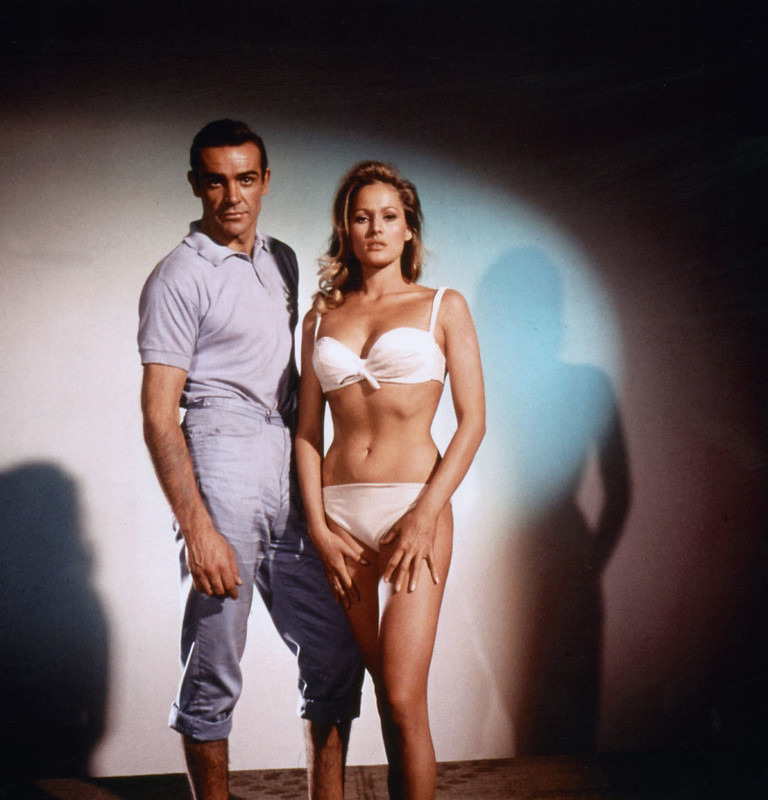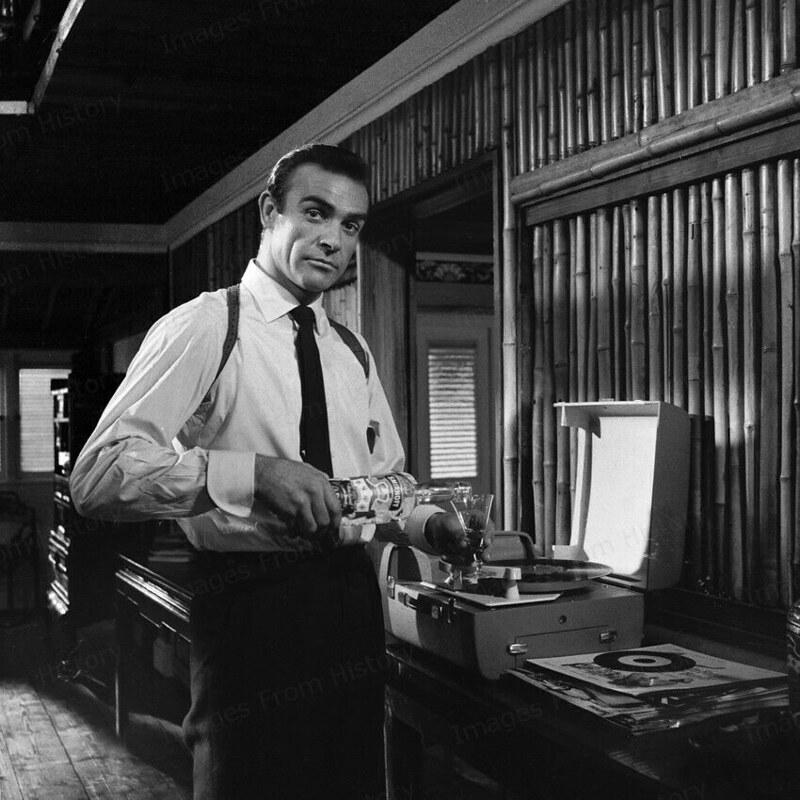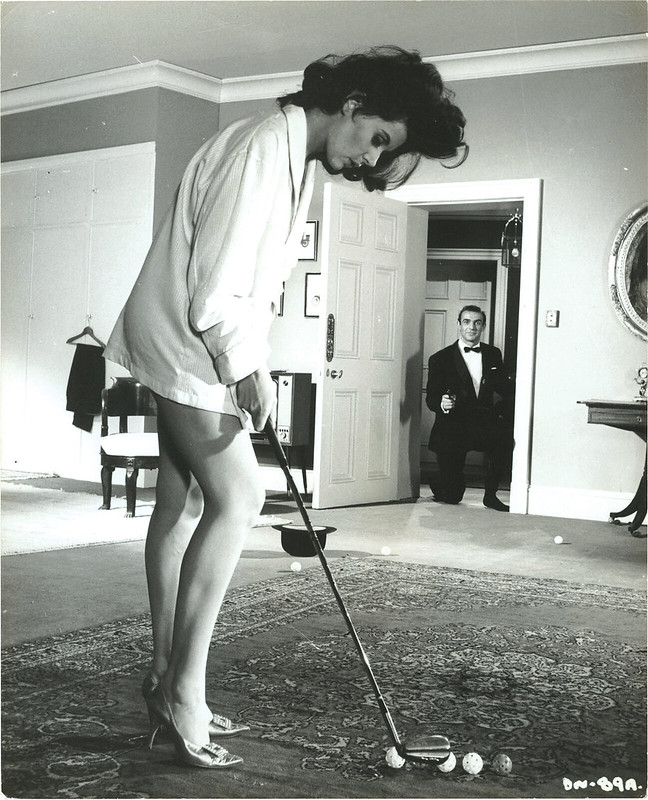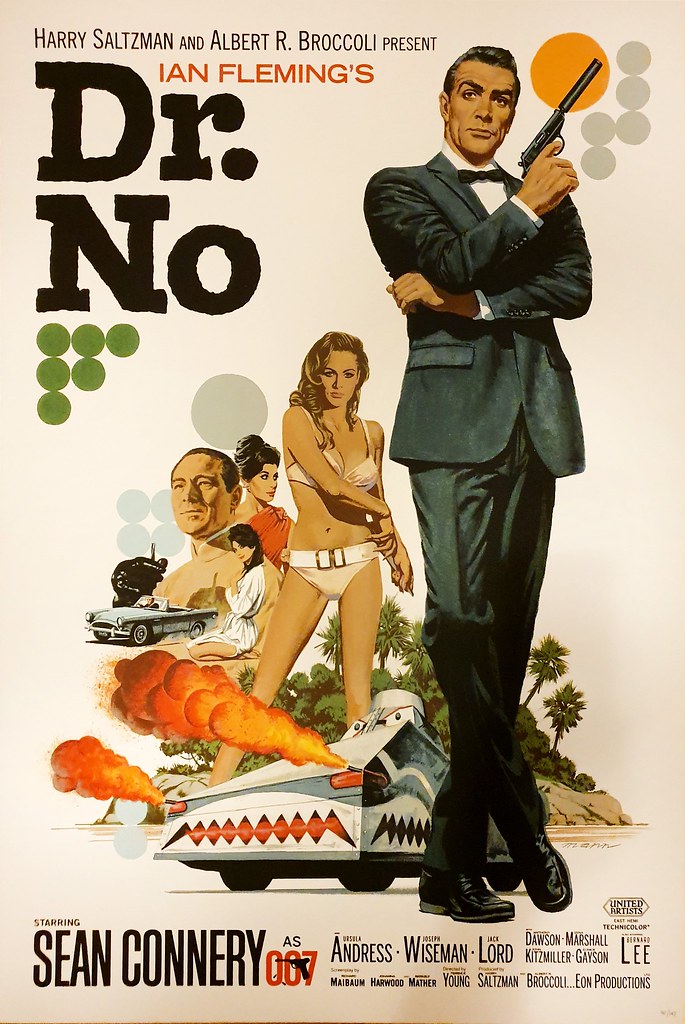WHAT: Dr. No (1962, 4K DCP) 60th anniversary screening
WHEN: May 18, 2022 1 PM & 7:30 PM
WHERE: Pickwick Theatre, Park Ridge, IL
WHAT ELSE: James Bond author Raymond Benson introduces the film at 7:30 PM; Colin Clark of the Ian Fleming Foundation will have Bond memorabilia in the lobby; Jay Warren performs pre-show music at 007 PM.
HOW MUCH: $12/$10 advance or $10 for the 1 PM matinee
Advance tickets: Click Here!
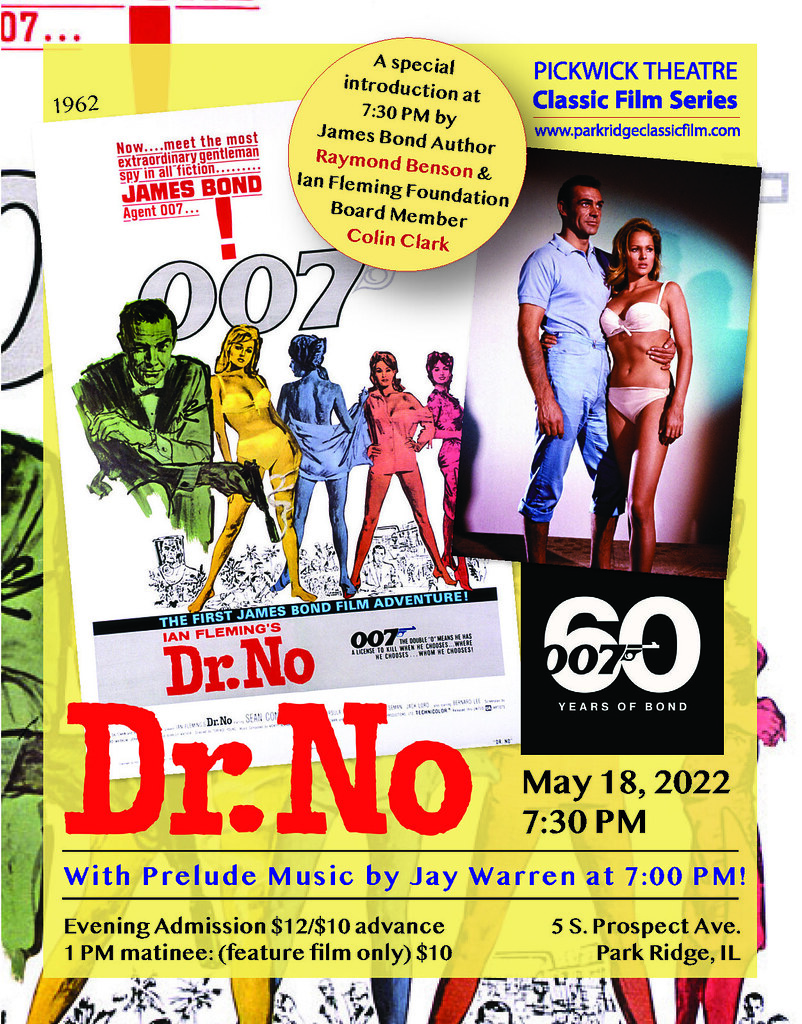
“I admire your luck, Mr…”
(lighting a cigarette)
“Bond. James Bond.”
It’s been sixty years since Sean Connery first said those words in Dr. No (1962). The line and the film introduced a new kind of hero and kicked off one of the most successful franchises in movie history. After twenty-five films and seven billion in profit, the James Bond legacy continues to grow. Yet, much of what we see today in the newer films can be traced back to Dr. No. The first film established a standard of excellence and laid the foundation for what was to come.
On May 18, 2022, the Pickwick Theatre Classic Film Series will celebrate sixty years of James Bond on film with a special screening of Dr. No. Joining us as our guide through its history will be James Bond author Raymond Benson. He will introduce the film at 7:30 PM. Ian Fleming Foundation Board Member Colin Clark will also be on hand in the theatre lobby with an anniversary Bond display.
Creating a Legend
Seventy years ago, author Ian Fleming wrote the first James Bond novel, Casino Royale, which was published the following year in 1953. In 1954, there was a television version of the book which didn’t make much of an impression. However, by the late 1950s, Ian Fleming’s novels had attracted the interest of American producer Albert R. “Cubby” Broccoli. At the time, Broccoli was working in the UK with his partner, Irving Allen. The two had formed Warwick Films in the early 1950s and had released several films through Columbia Pictures. In his attempt to get the rights to make a James Bond film, Broccoli arranged a meeting between Allen and Ian Fleming. However, the meeting was a disaster with Allen apparently disparaging Fleming’s work. As a result, it seemed unlikely that Broccoli would ever make a Bond film, at least, one with Allen as his partner.
Two years later in 1960, a Canadian-born producer named Harry Saltzman left his own production company in the hope of finding something more commercial than the kitchen sink realist films he had been making. For $50,000, he was able to secure from Fleming a 6-month option on the James Bond novels– all of them were on the table except Casino Royale. However, Saltzman had great difficulty finding financing and was running out of time. Meanwhile, Cubby Broccoli still had the passion to make a James Bond film. Cubby was informed by his friend and writer, Wolf Mankowitz, that Saltzman had the option. A meeting was subsequently arranged between the two producers.
Harry Saltzman was not interested in giving up his option, but he was willing to be a partner with Cubby Broccoli. The latter had already split up with Irving Allen. Broccoli and Saltzman came to an agreement, and as a result, they formed two companies: Danjaq would hold the rights to the films and Eon Film Productions would produce the films. Dr. No (the sixth James Bond novel) was selected as the first James Bond film primarily because it would be the easiest to make in terms of budget. The story was set mostly in one location, Jamaica, and only one large set-piece was needed to be constructed. The two men were able to secure financing through United Artists. A deal was reached fairly quickly through UA’s Vice-President, David Picker. Dr. No was given a budget of a million dollars.
A treatment was then developed by Wolf Mankowitz– the man who brought Broccoli and Saltzman together– and Richard Maibaum, who had written several screenplays for Broccoli’s Warwick Films. Mankowitz would later drop out and insist his name be removed; he believed the project was certain to be a failure. Johanna Harwood and Berkely Mather would also contribute to the final screenplay. During this creative process, the producers insisted that the screenplay adhere to the Ian Fleming novel.
After the murder of British operative Strangways, agent James Bond is sent to Jamaica to investigate. MI6 believes there may be a connection between Strangways’ death and the recent disruptions of rocket launches at Cape Canaveral– a matter the CIA is also investigating. Bond meets Quarrel, Strangways’ contact in Jamaica, and Felix Leiter of the CIA. From the latter, Bond learns that the source of the radio jamming has been traced to Jamaica. A clue involving mineral samples leads Bond to believe the signal could be coming from Crab Key– an island forbidden to natives. After an assassination attempt on Bond’s life by a local geologist named Dent, Bond and Quarrel head to Crab Key. Before long, Bond finds a beautiful orphan girl on the beach named Honey Ryder, a flame-shooting “land dragon,” and the mastermind behind the island’s secrets, Dr. No.
Of the many names floated about to helm the film, it was British filmmaker Terence Young who was selected. He already had a prior association with Broccoli’s Warwick Films. It would be Young who would establish the style of the film series and define the James Bond character. It’s been suggested that Young gave Bond his own sense of savoir faire. He would also make significant contributions to the script.
There were several possibilities as to who would play Agent 007. Terence initially wanted Richard Johnson. Cary Grant, who was Best Man at Cubby Broccoli’s wedding, would have elevated the status of the project, but he was only committed to doing one film– not a series. (According to Grant’s daughter, he later regretted his decision not to do it.) Instead of making just one with Grant and then being forced to undertake another search, the filmmakers looked elsewhere. Harry Saltzman claimed that Roger Moore was considered, but Moore insisted it wasn’t until years later that he was actually approached by Broccoli and Saltzman.
Polish producer Benjamin Fisz was a friend of Harry Saltzman and suggested he take a look at an actor named Sean Connery, who had appeared in Fisz’s On the Fiddle (1961). Connery, a former Mr. Universe contestant, had also recently starred in Darby O’Gill and the Little People (1959), which was screened by the producers. When they brought Connery in for an interview, they realized he had the look and swagger they wanted. Terence Young, who had worked with Sean previously on Action of the Tiger (1957), felt he moved the way James Bond would. Ian Fleming, however, was not sold– at least, initially. Connery was everything his literary Bond was not: Scottish, working-class, and a little too rugged.
There was also some resistance to Sean from United Artists, but in the end, they trusted the producers to make the right creative decisions in regards to cast. At this point in his career, Sean was very much a rough diamond, and that’s how he was seen in the eyes of Terence Young. It would be Young’s task to take what Ian Fleming had written and translate it to the screen. In order to accomplish this, he had to shape Sean into the “gentleman” agent. Young essentially coached Sean and taught him a lot of things he knew about elegance, style and dress– even making sure he would be finely tailored.
Sean Connery had an on-screen magnetism– a virile quality– and he also had that dry humor that would become associated with the role. This would evolve into the classic one-liners audiences typically associate with the series. Terence Young had said that “a lot of things in this film, the sex and violence and so on, if played straight, a) would be objectionable, and b) we’re never gonna go past the censors; but the moment you take the mickey out, put the tongue out in the cheek, it seems to disarm.”
Though Ian Fleming had made his own attempt to coax his friend and neighbor Noel Coward into playing Dr. No– he flatly refused– the producers hired New York actor Joseph Wiseman. The character was a half-Chinese, half-German villain partially inspired by Sax Rohmer’s Fu Manchu. Joseph Wiseman set the standard, and his characterization became the template for the Bond villains to follow: urbane and calculating.
American actor Jack Lord was cast as the screen’s first Felix Leiter (a character not in the novel). Eunice Gayson portrayed Sylvia Trench (technically, the first Bond girl), Lois Maxwell was Miss Moneypenny (after passing on the Trench role), John Kitzmiller played Quarrel, Anthony Dawson was Professor Dent, Zena Marshall played Miss Taro, and Bernard Lee was fortuitously cast as Bond’s chief, M. Lee would go on to play the role with distinction in ten more films after Dr. No.
Just two weeks before the start of filming, Swiss actress Ursula Andress was cast as the seashell-collecting Honey Ryder. The producers had seen photos of her taken by her actor/husband John Derek (best-known as Joshua from The Ten Commandments). She accepted the role only after Kirk Douglas convinced her to do it at a party. Andress was one of the most beautiful women in the world, but due to her heavy accent, her voice was dubbed by Nikki van der Zyl. Andress’ role proved to be that of the quintessential “Bond Girl.” The image of her walking out of the sea in her white bikini (while singing “Under the Mango Tree”) has become one of the most iconic images in the James Bond series– a moment so indelible they tried to recreate it in the dismal Die Another Day (2002) with Halle Berry.
The cast and crew traveled to Jamaica, and on January 16, 1962, the first James Bond footage was shot. Cameras rolled on the scene depicting Bond arriving at the Kingston airport and walking past a photographer (played by Miss Jamaica, Marguerite LeWars). The majority of Dr. No would be shot in Jamaica, which is where Ian Fleming resided on his “Goldeneye” estate. It was Ian who suggested Chris Blackwell to serve as location manager. Dr. No took full advantage of its scenic locations, particularly the Laughing Waters Estate where Bond meets Honey Ryder on the Crab Key beach. Dr. No would be the first of seven James Bond films shot by cinematographer Ted Moore.
Stuntman Bob Simmons became another key figure in the James Bond series. He choreographed the fight scenes, such as 007’s fight with a chauffeur. This action was further enhanced by Peter Hunt’s editing, which made the fights even more exciting through their exaggeration. Hunt’s sense of movement and quick cuts often broke the rules of traditional editing. Coincidentally, it is Bob Simmons (not Sean Connery) who is first seen in the opening “gun barrel” sequence. The shot, conceived and executed by title designer Maurice Binder, would go on to introduce every Eon-produced Bond film up until the Daniel Craig era.
After location shooting was completed, the production moved back to Pinewood Studios in England. Here, many of the interior scenes were filmed. If there was one person who defined the visual aesthetic of the Bond films more than any other, it was production designer Ken Adam. His larger-than-life, semi-futuristic sets were an integral component of what made a classic Bond film. Ken Adam would work on seven Bond pictures in total. His nuclear reactor control room in Dr. No is the film’s main set-piece. However, through the magic of camera lenses, the set looks bigger on screen than it was in real life.
Joseph Wiseman, Sean Connery, and Ursula Andress
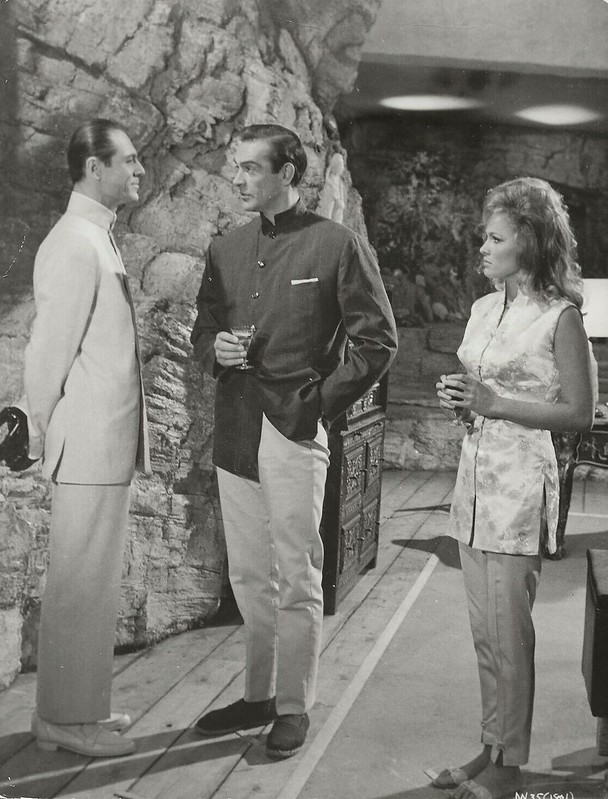
Composer Monty Norman wrote the James Bond theme with elements he lifted from his own “Good Sign, Bad Sign”– a song composed for the aborted musical “A House For Mr. Biswas.” The arrangement of Norman’s composition was performed by John Barry. It’s Barry’s contributions and enhancements that turned a few usable bars from Norman’s song into the James Bond theme as we know it today.
Dr. No premiered on October 6, 1962. (It didn’t reach the United States until May of 1963.) The film did well at the box office, and as a result, the budget for the next film, From Russia With Love, was doubled. Dr. No would make most of its profits, however, through reissues. It was re-released as part of a double feature with From Russia With Love after Goldfinger came out in 1964. Dr. No initiated a phenomenon that would grow throughout the 1960s with each successive Bond adventure.
Over the course of sixty years, there have been many highs– some, an all-time high– and a few lows, but the series remains strong because of its relative consistency in its standards and production values. The series continues to re-invent and re-boot itself while honoring the traditions of the past. So much of what audiences see today can be traced back to its cinematic origin sixty years ago.
Dr. No is our first James Bond event in the wake of Sir Sean Connery’s passing on October 31, 2020, at the age of 90. Our screening is dedicated to him.
~MCH
For more about the making of Dr. No, we recommend the documentary Inside ‘Dr. No’ (2000) as well as the Michael Coate article from Cinema Retro, which reflected upon the film’s 55th anniversary. Click Here!


